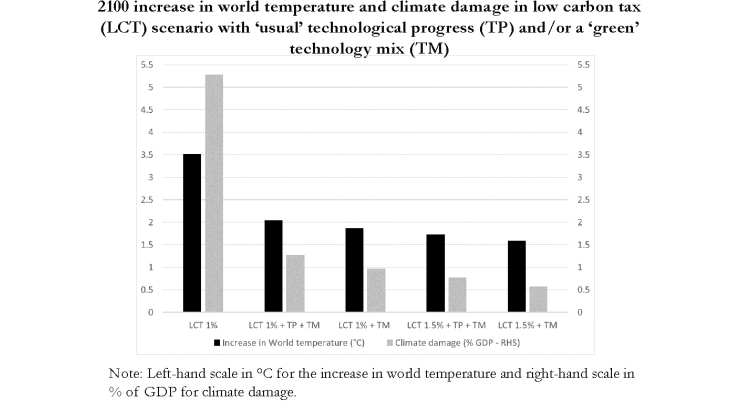According to the IPCC (2022a) or the IEA (2021) scenarios, technological progress must be an important part of the mix to reach net zero greenhouse gas (GHG) emissions and limit climate warming. The role of technological progress relies on future innovations, but also requires their diffusion and the diffusion of past innovations. Indeed, for some technologies (for example Direct Air Carbon Capture), future innovations are expected to occur, while there may be other innovations in yet unforeseen directions (radical innovations). Obtaining the gains in terms of CO2 (carbon dioxide) emissions from these technologies requires investing in the clean energy infrastructure and the physical equipment that embeds them. Yet, the stock of underutilised past CO2-saving innovations is still considerable, for example in the building sector to reduce heating needs.
This paper highlights how technology can contribute to reaching the COP21 goals of net zero CO2 emissions and global warming below 2°C in 2100. It quantifies the contribution of technologies to CO2 emission reduction and the limitation in damages from climate change. It uses the Advanced Climate Change Long-term model (ACCL) by Alestra et al. (2022), which is particularly adapted to quantify the consequences of energy price shocks and technological improvements on CO2 emissions, temperature changes, climate damage and GDP. It distinguishes five types of energy, four being “dirty” in terms of CO2 emissions (coal, petrol, gas, “dirty” electricity) and one being “clean” (“clean” electricity). This model gives an interesting and transparent insight into the role of technologies in the energy transition and climate mitigation mechanisms. We consider three technological: energy efficiency gains, carbon capture and a decrease in the relative price of “clean” energy. This last component can correspond to the result of innovation or a tax/subsidy-oriented policy. The simulations show that without climate policies global warming may be +5°C in 2100, with considerable climate damage. An acceleration in ‘usual technical progress’ -not targeted at reducing CO2- even worsens global warming and climate damage. According to our estimates, the world does not achieve climate goals in 2100 without green technologies. Intervening only via energy prices, e.g. a carbon tax, requires challenging hypotheses of international coordination and price increase for polluting energies. We assess a multi-lever climate strategy combining energy efficiency gains, carbon sequestration, and a decrease of 3% per year in the relative price of “clean” electricity with a 1 to 1.5% annual rise in the relative price of polluting energy sources (corresponding to a low but achievable carbon tax or LCT scenario).[1] None of these components alone is sufficient to reach climate objectives. Our last and most important finding is that our composite scenario achieves the climate goals.
In the figure above, we consider four composite scenarios combining our Low Carbon Tax (LCT) scenario, the global rise of the relative price of CO2-emitting energy sources by 1 or 1.5% a year for the whole period, with either or both the ‘usual’ TP and a ‘green’ technology package. On the one hand, the ‘usual’ Technological Progress (TP) hypothesis represents a technological shock that is not specifically oriented toward climate goals. We assume a 0.5 percentage point constant decrease in the investment relative price from 2017 to 2100 in all countries and areas. On the other hand, the ‘green’ Technology Mix (TM) is a combination of the different technological hypotheses, which are directly oriented toward the objective of a decline in the stock of GHG. We keep our calibration based on IEA (2021) for the energy efficiency gains of 1.6% per year and the CO2 sequestration through CCUS technologies of 7.6 Gt a year, and our decrease in the relative price of non-carbon-emitting electricity by 3% a year (all of them assumed identical for the entire world and time span).
We show that, in the absence of a new technical breakthrough, the combination of an increase in CO2-emitting energy prices by 1% a year and the technology mix divides worldwide net carbon emissions by 14, keeps global warming below 2°C and limits climate damages to 1% of world GDP in 2100. Thus, only a composite scenario adding technological action to a realistic increase in the relative prices of “dirty” energy can achieve the climate goals. Nevertheless, such a program appears very challenging. Indeed, its implementation needs to start immediately and be coordinated in all countries, an assumption difficult to meet considering the current geopolitics. A late or incomplete implementation means that efforts will have to be stronger in a second phase to compensate for higher gas emissions in the meantime or that we concede less ambitious climatic goals. These two situations correspond to a failure and clearly express that we renounce losing a small part of comfort and quality of life in the present for a high price, in terms of climate damage, for next generations in the future.
[1] With this scenario, we introduce a climate policy that raises annually the relative price of coal, oil, natural gas and CO2-emitting electricity by 1%, in each country / region, for the whole period. It is detailed and already commented in ACCL (Alestra et al., 2022) in which the reader can find more details.
